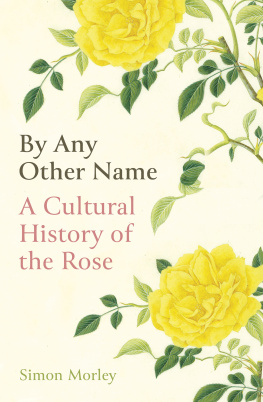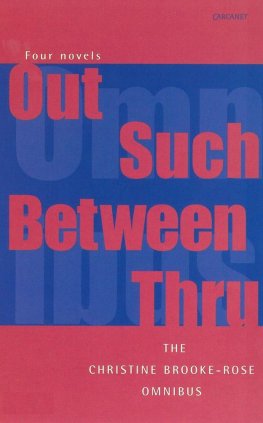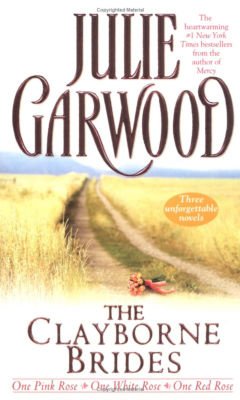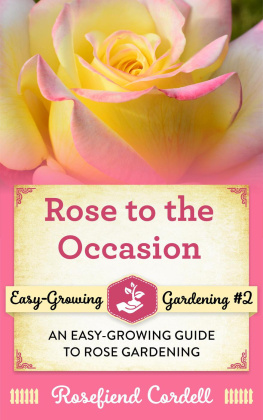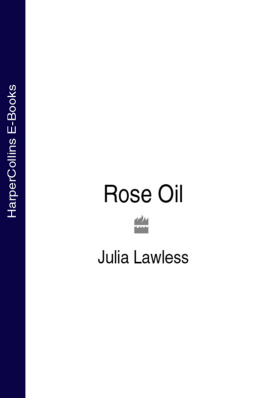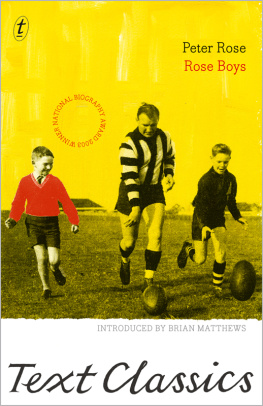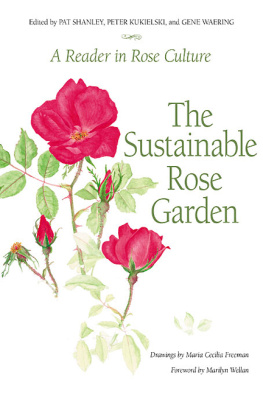Acknowledgements
This book sits on the shoulders of many others far too numerous to acknowledge here. But I would like to especially note my debt to the following books. For roses in general: Classic Roses by Peter Beales; In Search of Lost Roses by Thomas Christopher; Roses by Gerd Krssmann; The Rose by Jennifer Potter; and The Royal Horticultural Society Encyclopaedia of Roses by Charles and Brigid Quest-Ritson. For the symbolism of the rose: Culture of Flowers by Jack Goody and The Symbolic Rose by Barbara Seward. For a thought-provoking background: Plants as Persons by Matthew Hall; The Cabaret of Plants by Richard Mabey; The Revolutionary Genius of Plants by Sefano Mancuso; Plant Thinking by Michael Marder; and The Botany of Desire by Michael Pollan.
For their expert knowledge of the rose as a plant and for fact-checking the relevant chapters in my book, I would like to thank: Jonny Norton, Head Gardener, Mottisfont Abbey Rose Garden, whom I also thank for allowing Oneworld to use one of his beautiful photographs of the rose garden; Kim Wook-Kyun, President, South Korea Rose Society, and Yuki Mikanagi, former Chairperson of the Conservation and Heritage Committee of the World Federation of Rose Societies, for excellent advice. Thanks also to Fabien and Florence Ducher of Roseraie Ducher for an insightful interview and for helping augment my rose garden. And thanks to Chang Eungbok for the wonderful design for the endpapers.
Also, thanks to: Roger Vlitos, Curator of the Farringdon Collection at Buscot Park; the staff at the Lindley Library, RHS, London, especially Charlotte Brooks, Art Curator. Also, thanks to the RHS for letting us use the wonderful watercolour in their collection for the cover; Elizabeth Perks of the Rosarian Library (www.therosarianlibrary.co.uk) for helpful suggestions and encouragement; Lindy Usher who early on encouraged my interest in roses, and for research concerning Rumi.
A very big thank you to my agent, Clare Grist Taylor, whose clearsighted expertise at the proposal stage made this book much more coherent, and who found a wonderful home for it. Huge thanks at Oneworld to my editor, Cecilia Stein, who knocked the manuscript into shape; Elizabeth Hinks, for eagle-eyed copyediting; Rida Vaquas, for picture and literary rights research; Paul Nash, Head of Production; Kate Bland, for publicity; and Matilda Warner, for press.
So far in these Acknowledgements I have managed to avoid rose-inspired metaphors, but here is one to end with: They say that in any relationship there is one partner who is the gardener and another who is the rose. My thanks to my partner, Chang Eungbok, for taking it in turns.
CHAPTER FOURTEEN
Rose NRoses
The Rose Business
If you want to test the roses pervasiveness within todays consumer society, a department store is a good place to start. I chose John Lewis on Oxford Street, and walked there directly after my rose-hunt in the National Gallery. Once at the store, I made straight for the cosmetics hall on the ground floor. At Dior, I tried the new Eau de Toilette Rose NRoses, which had been recently launched to coincide with Valentines Day 2020, joining the six other Miss Dior rose-based perfumes (the first appeared in 1947). I asked the two sales assistants what specific type of rose was used for the perfume, and one of them replied, the Grass Rose, which threw me for a moment, until I realized she was referring to the Grasse Rose, that is, Rosa centifolia , the Cabbage Rose or the Rose of Provence (the roses in van Goghs painting). In the twelfth century, returning Crusaders may have carried knowledge of rose distillation back with them to western Europe, although such knowledge could have arisen independently in Europe. Eventually, the rose became an important ingredient for the Western perfume industry, and in the sixteenth century, around the town of Grasse in southern France, rose cultivation developed for this purpose. Rosa centifolia was the species of choice, and remains today at the heart of a thriving business. Dior, Chanel and Herms all source their roses in Grasse.
I discovered that Rose NRoses is a lively and sparkling fragrance and wasnt too sweetly floral. I then went directly over to Lancme, and tried their La Vie est Belle en Rose, launched a year earlier for Valentines Day 2019 as a further iteration of their successful La Vie est Belle perfume. But as I am wholly ignorant of, and seemingly rather insensitive to, perfume, I couldnt really tell the difference between the two. Feeling somewhat light-headed, I proceeded to explore the rest of the store, and found roses adorning scarves, blouses, skirts, dresses, hats, lingerie, crockery, china, cushions, furniture and lampshades. There were also artificial rose flowers, including a lovely red polyester Rosa centifolia , retailing at a very reasonable 8. Valentines Day had recently passed, but Mothers Day was looming, so there were also rose-themed promotions for this important event.

We tend to think of roses mostly in relation to their symbolic or ornamental value, but as we have seen, historically, and also today, the rose business takes many forms. There are not just roses for planting, or cut roses for bunches, bouquets and wreaths but also, as the cosmetics hall at John Lewis reminds us, roses for perfume. In some parts of the world, as we have seen, there are roses for both culinary and medicinal purposes. Roses have been lucrative for more than 5,000 years, which makes their cultivation one of the longest running commercial enterprises in the world.
If an Ancient Roman could afford it, he or she arranged for thousands of fragrant and soft rose petals to be dropped from above onto the banqueting guests. In a previous chapter, I mentioned Alma-Tademas painting The Roses of Heliogabalus (1888), in which the Victorian artist sought to evoke the decadence of ancient Rome through a scene of excessively extravagant floral display. In the painting, one can also see that the languorous guests are wearing rose chaplets garlands for their heads. Such sartorial accessories were common in many social situations, sacred and profane.
The Romans set a day aside annually in May or June called Dies Rosalia or Rosaria (Feast of Roses), which required the assiduous cultivation and marketing of roses to satisfy demand. Flower sellers abounded, and it was sometimes deemed a morally dubious profession, as a poem attributed to Dionysius the Sophist suggests: You with the roses, rosy in your charm; but what do you sell, yourself or the roses, or both? In the region around Pompeii, Paestum and Capua, the products of local rose cultivation were intended for a large market, spreading beyond the Italian peninsula. Roses were grown in greenhouses and under glass, so that they were available all year round. But such was the demand that Italy could not grow enough of them, and they had to be imported from Syria and Egypt.
But after the fall of Rome the flower business went into steep decline, and one can imagine the Dark Ages as metaphorically dark because of the absence of colourful, aromatic flowers. As we saw, rose chaplets, garlands and offerings were condemned by the Church, as was the use of flowers in commemoration of the dead. But by the fourteenth century, flowers worn as ornamental and sacramental chaplets were again commonplace. Conventions of floral body decoration also evolved in secular contexts, as several works in the National Gallery showed, and until the mid-twentieth century roses were a standard fashion accessory, not only for ladies but also for gentlemen, who wore them as buttonholes. The high demand ensured a lively business in cut roses.
Another practical and profitable use for the rose, although not so much in western Europe, is the production of rose water and the perfumed attar of roses. The latter involves distilling volatile oils from the flowers, and knowledge of this process dates from at least the first century AD. By the ninth century attar of roses was being exported from, especially, the Fars region in Persia to places as far afield as Spain, India and China. From the tenth to the seventeenth century, Persia was the acknowledged centre of the industry, and the Damask rose was cultivated for this purpose especially around Shiraz in the Fars province, and still is to this day. Rosa centifolia is also used for this purpose in the Near East. The Moors brought the technology of rose-water production to southern Spain, and the Moghuls to India, and a tradition says that it was actually Queen Noor Jehan in sixteenth-century India who discovered rose oil or attar when she collected droplets of the oil from a canal flowing with rose petals. Today, roses for oil is a significant cash-crop in regions of India such as Kashmir and Uttar Pradesh.
Next page
